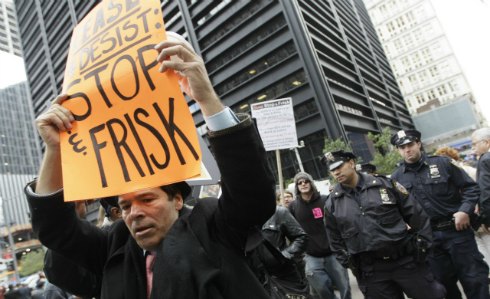
Every year for the past decade, under the agency’s “stop-and-frisk” program, New York City police officers have stopped 500,000 to nearly 700,000 citizens on the city’s streets. Nearly 90 percent of those stopped are Black and Hispanic men, women and children.
The department’s own data show that at most only 12 to 14 percent of these stops result in an actual arrest – and only about half of those arrested are ultimately convicted of some transgression.
Is that the definition, as the city administration and police department claim, of an effective crime-fighting program?
Or is the program a cynical cover for police “make-work:” harassing innocent civilians in order to churn statistics of an operation that has virtually no effect on reducing crime – and burnish the department’s reputation and that of Mayor Michael R. Bloomberg as effective crime-fighters?
Those are the questions behind the central constitutional issue at the heart of a class-action lawsuit challenging New York’s controversial stop-and-frisk program now being heard in a federal district court in Manhattan.
The suit, brought by the New York City-based Center for Constitutional Rights, reaches the court after years of complaints from the city’s Black and Hispanic communities, and civil rights and civil liberties advocates against both the Bloomberg stop-and-frisk program and earlier, similar police department programs.
That long record has produced legislation from the New York City Council that would establish an office of inspector general for the police department, which would have subpoena power to investigate police actions. The legislation, bitterly opposed by Mayor Bloomberg and Police Commissioner Raymond W. Kelly, is inextricably enmeshed in this year’s mayoral campaign. Bloomberg cannot run again; and does not want Christine Quinn, the Council’s Speaker, to be his successor. She is a chief sponsor of the legislation, and also said there’s enough support for it on the Council to override Bloomberg’s promised veto..
The street-stops case is also being heard in the wake of a January federal court decision on a similar police department program in which landlords of thousands of private buildings in The Bronx gave the department permission to patrol their buildings and arrest trespassers. The judge in that case found that the police searches of individuals routinely violated citizens’ 4th Amendment rights and said it needed to be modified if it is to continue.
That judge was Shira A. Scheindlin, who is also hearing the current, broader case involving police street stops.
The Supreme Court has long upheld the right of police officers to stop and question civilians on the street; but they must have reasonable cause – not just a hunch – to search individual’s belongings or person.
Bloomberg and Kelly have repeatedly declared the stop-and-frisk program integral to the police department’s success in reducing crime.
But critics assert that the city has never presented any statistics or other data establishing a direct connection between the program and the fact that the city’s crime rate has declined during the past decade. Donna Lieberman, executive director of the New York Civil Liberties Union, told the New York Times last month that “A gun — the ostensible reason behind the stop-and-frisk regime — was found in 0.1 percent of stops,” she added. “That is an unbelievably poor yield rate for such an intrusive, wasteful and humiliating police action.”
The street-stops trial opened last week with the wrenching testimony of three Black men who told of being stopped and frisked, and in one instance, momentarily handcuffed. “To be treated like that, by someone who works for New York City, I felt degraded and helpless,” said Nicholas K. Peart, 24, who is the legal guardian of his two young brothers and 20-year-old disabled sister. In December 2011, Peart, a college student, wrote a widely-discussed op-ed article in the New York Times about the five times police have stopped and frisked him in the last decade.
Witnesses for the plaintiffs also included two police officers who testified that patrol officers in their precincts were told they must meet a departmental monthly quota of 20 summonses and at least one arrest, or else they would be punished. Such a police practice is illegal, and the two officers’ claims were vigorously denied by the city’s lawyers in court and the police department’s chief spokesman. But both officers supplied tape-recordings they secretly made of precinct-station conversations that seem to support their claims.
As this column is being written, the commanding officer of one of the patrolmen will soon be called to testify about his criticism of the cop for not stopping and frisking the “right people” – which he later defined as “male Blacks 14 to 20, 21.”
His tape-recorded words, defending a program with an atrocious record of identifying the “right people” of any age to stop for questioning, should underscore that all citizens deserve police officers who are committed to being protectors, not predators.
Lee A. Daniels is a longtime journalist based in New York City. His latest book is Last Chance: The Political Threat to Black America.
